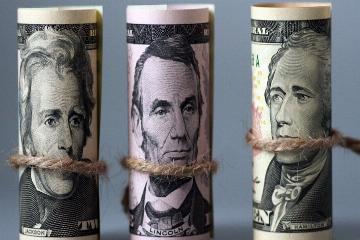The economic climate in the United States is filled with tension as a new storm brews in the form of rising discontent towards the recently passed Inflation Reduction ActDespite assurances from the Biden administration that it intends to adjust certain provisions of the law to appease European allies, the message remains clear: no major revisions will be made to placate discontentThis steadfast approach stems largely from the pressing need to address the ongoing economic struggles facing the nation.
The persistent inflation has left financial markets restless, with continued fears surrounding the Federal Reserve's interest rate policy causing turbulenceThis cycle of inflation and interest rate hikes has many analysts concerned that it will inevitably accelerate an impending economic downturnRecent data released on December 6 illustrates this unease as the Dow Jones Industrial Average dropped over 1% following updates on the ISM services index and non-farm payrolls for November
Advertisements
The impacts spread across various sectors, particularly oil markets, which experienced significant declines as well.
Tech Giants at the Forefront of Market Decline
By the closing bell, the financial indicators reflected a troubling picture; the Dow Jones fell by 350.76 points to settle at 33,596.34—a loss of 1.03%. The Nasdaq witnessed a steeper drop at 225.05 points, resulting in a 2% decline, while the S&P 500 fell by 57.58 points or 1.44% to conclude at 3,941.26. Notably, sectors such as energy, social media, and semiconductors faced headwinds, with major tech stocks taking the brunt of lossesNoteworthy declines included a 3.03% drop for Amazon, 2.54% for Apple, and a staggering 6.79% reduction for Meta.
In a peculiar twist, Chinese tech stocks found some respite with iQIYI surging by 5.71% and Bilibili increasing by 4.4%. However, this rally did little to mask the broader declines gripping the market.
Amidst the stock market turbulence, U.S
Advertisements
Treasury yields fell, exacerbating the inversion of the 2-year/10-year Treasury yield curve—a key economic indicatorConcurrently, the energy sector faced its own challenges, with oil prices plummeting to their lowest levels of the yearWest Texas Intermediate crude fell by $2.68, closing at $74.25 per barrel, marking the lowest closure since December 2021, while Brent crude also dipped by 4% to rest at $79.35 per barrel.
With uncertainty reigning over the Federal Reserve's interest rate decisions, a significant flow of capital has migrated towards safe-haven assetsThe U.Sdollar increased by 0.29% against a basket of six major currencies, reflected in the DXY index which closed at 105.57. Additionally, COMEX gold futures saw a modest rise of approximately 0.1%, closing at $1782.40 per ounce, showcasing the market's shift in sentiment towards stability amidst fluctuating equities.
European stock markets mirrored U.S
Advertisements
trends, experiencing widespread declines as major indexes fell similarlyThe DAX 30 in Germany saw a 0.7% decrease, while the UK's FTSE 100 and France’s CAC 40 also closed lowerSuch declines reflect a broader pattern of concern sweeping across economic landscapes globally.
Recent data from the U.SLabor Department revealed that non-farm payrolls increased by 263,000 jobs in November, surpassing expectations of 200,000. Although job growth appeared robust, this dynamic raises concerns among market participants who fear that the Federal Reserve will have to tighten monetary policy even further to combat inflationary pressuresDeutsche Bank issued a cautionary note, suggesting that the likelihood of an easing in Federal Reserve policies has been overrated given the strength of the employment report, which could indicate sustained inflation.
Wall Street's Gloomy Outlook on the Economy
A recent Gallup poll conducted on December 6 found that 55% of Americans reported experiencing economic hardships due to inflation, a marked increase from 45% in the previous year
- Credit Suisse Implosion Sparks Global Financial Jitters
- Gold Prices Soar Above $2000!
- DeLijia's IPO: Poised for Growth Amidst Challenges
- Sunac China Faces New Liquidation Challenge
- Country Garden Navigates a Major Crisis
Alarmingly, 13% indicated that their economic difficulties had reached severe levelsThe situation appears even more pronounced among lower-income respondents, with 28% reporting significant economic strifeMeanwhile, 60% of middle-income participants acknowledged having faced some form of economic difficulty—an increase from under 50% last yearEven among high earners, the percentage reporting economic hardship climbed from 28% to 42% over the same period.
As forecasts for a recession in 2023 gain steam on Wall Street, major institutions are aligning with this sentimentJamie Dimon, CEO of JPMorgan Chase, cautioned that inflation could push the U.Seconomy into a recession next year despite present consumer and corporate buoyancyIn line with this, Deutsche Bank's Chief Economist anticipates that a recession may commence in mid-2023.
Morgan Stanley’s bearish strategists also recommend cashing out on recent stock gains, reflecting a consensus that recent rebounds in the market may not last

David Solomon, CEO of Goldman Sachs, echoed these sentiments, emphasizing that geopolitical uncertainties combined with Federal Reserve rate hikes have made institutions and their clients increasingly cautious about future investments.
Forecasts posit that the U.Scould face a recession in 2023, with a 35% chance of a "soft landing" where growth stabilizes around 1%, and inflation lingers at about 4%. Compounding the sense of urgency are signals from Goldman Sachs, hinting at potential layoffs as the firm anticipates a slowdown in growth across its various business lines.
Back in September, Goldman commenced its largest round of layoffs since the pandemic began, planning to cut hundreds of positionsIn fact, hints of a recruiting slowdown had emerged as early as July, alongside a return to annual performance evaluations.
Amid these economic clouds, executives from various companies, including Elon Musk of Tesla and Twitter, Sundar Pichai of Alphabet, and former Amazon CEO Jeff Bezos, have all voiced concerns regarding the likelihood of a recession in the upcoming year.
 April 8, 2025
April 8, 2025